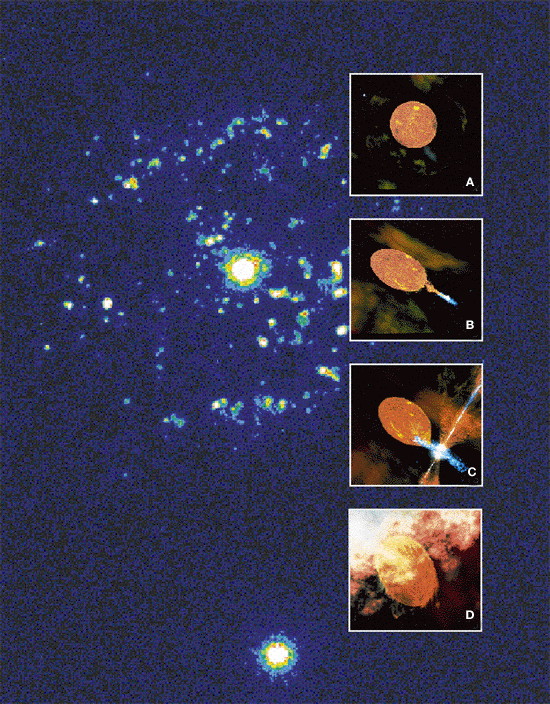

(Background) This is one of the sharpest images of a nova, shown here ejecting hot gas at high speeds from a binary-star system. Known as T Pyxidis, this recurrent nova periodically erupts about every 20 years. It resides nearly 2000 pc away in the dim southern constellation Pyxis. However, instead of a smooth shell of gaseous debris spread across a region of space roughly a light year across, the image reveals blobs of glowing matter, each roughly the size of our solar system, possibly the result of the newly erupted matter plowing into the debris of older, "fossilized" matter from previous eruptions.
(Inset A) An artist's conception helps us to visualize one possible explanation of T Pyxidis's periodic outbursts. Here, a white-dwarf star (upper left) orbits about a cool red-giant star; an elliptical orbit regularly brings the dwarf close to the giant.
(Inset B) The red giant spills some matter onto its companion, forming an accretion disk (lower right), drawn here as a swirling, flattened, blue vortex of hot gas.
(Inset C) As matter continues transferring, causing the process to become unstable, the disk erupts—at first gently as plasma escapes in bipolar flows (or geysers) perpendicular to the disk.
(Inset D) As the companion becomes overloaded with in-falling matter, spontaneous nuclear fusion occurs on or near its surface, resulting in a full-scale nova. The process repeats periodically, causing a "recurrent nova."
Studying this chapter will enable you to:
Explain how white dwarfs in binary systems can become explosively active.
Summarize the sequence of events leading to the violent death of a massive star.
Describe the two types of supernovae, and explain how each is produced.
Describe the observational evidence that supernovae have occurred in our galaxy.
Explain the origin of elements heavier than helium, and discuss the significance of these elements for the study of stellar evolution.
What fate awaits a star when it runs out of fuel? For a low-mass star, the white-dwarf stage is not necessarily the end of the road. The potential exists for further violent activity if a binary companion can provide additional fuel. High-mass stars—whether or not they are members of binaries—are also destined to die explosively, releasing vast amounts of energy, creating many heavy elements, and scattering the debris throughout interstellar space. These cataclysmic explosions may trigger the formation of new stars, continuing the cycle of stellar birth and death. In this chapter we will study in more detail the processes responsible for these cataclysmic explosions and the mechanisms that create heavy elements from which we ourselves are made.